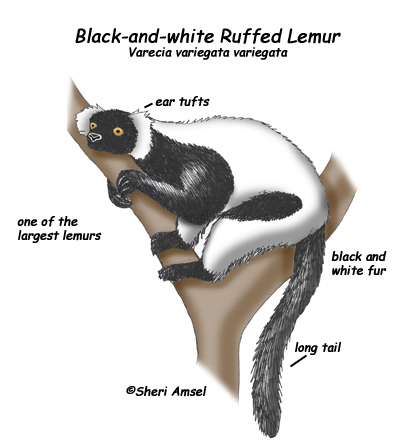

They are found on the island of Madagascar.
They live in the eastern rainforests.
They are one of the largest lemurs measuring up to 4 feet long, including their long tail. Their long tail doubles their length. They are slight in build though and usually weight less than 10 pounds. They are black and white with yellow eyes and white ear tufts.
They live in small groups and are territorial. They have loud calls to let other lemurs know where they are and to warn about predators. They are active during the day (diurnal).
They eat fruit and plants.
They are killed by snakes eagles, fossa and man.
Females are pregnant for 3.5 months (gestation) and have 2-3 babies.
They can live 18-20 years. They are listed as endangered.
Kingdom: Animalia
Phylum: Chordata
Subphylum: Vertebrata
Class: Mammalia
Order: Primates
Suborder: Strepsirrhini
Family: Lemuridae
Genus: Varecia
Species: Varecia variegata
When you research information you must cite the reference. Citing for websites is different from citing from books, magazines and periodicals. The style of citing shown here is from the MLA Style Citations (Modern Language Association).
When citing a WEBSITE the general format is as follows.
Author Last Name, First Name(s). "Title: Subtitle of Part of Web Page, if appropriate." Title: Subtitle: Section of Page if appropriate. Sponsoring/Publishing Agency, If Given. Additional significant descriptive information. Date of Electronic Publication or other Date, such as Last Updated. Day Month Year of access < URL >.
Amsel, Sheri. "Lemur (Black-and-white Ruffed)" Exploring Nature Educational Resource ©2005-2024. December 14, 2024
< http://www.exploringnature.org/db/view/Lemur-Black-and-white-Ruffed >

